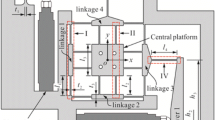Abstract
This paper presents the mechanical design and computational optimization for a flexure-based XY positioning platform that is capable of performing planar translational motion with two degrees of freedom in the-x and-y axes. During the mechanical design, the hybrid leaf spring and right circular hinges are adopted to increase the travel displacement and reduce the cross-axis coupling errors. These hybrid joints create the parallelogram structures which provide the functions of joint and transmission mechanisms with excellent decoupling properties. The statistics and dynamics of the mechanism are analyzed, and these analyses are validated with FEA and experimental results. A finite element analysis-based response surface methodology is utilized to solve the multi-objective optimization problems and thus the static and dynamic characteristics of the positioning platform are improved. The prototype is fabricated using a wire electric discharge machining technique. The experimentations are carried out to investigate the performance of the platform and verify the established performance characteristics and optimization methodologies. The experimental results reveal that the platform has a broad workspace range in excess of 125 μm × 125 μm with a first-order natural frequency of 740 Hz. The cross-axis coupling ratio is less than 0.6% verifying the excellent decoupling property.
Similar content being viewed by others
References
Choi, K.-B. and Lee, J. J., “Passive Compliant Wafer Stage for Single-Step Nano-Imprint Lithography,” Review of Scientific Instruments, Vol. 76, No. 7, Paper No. 075106, 2005.
Tian, Y., Shirinzadeh, B., and Zhang, D., “A Flexure-based Five-Bar Mechanism for Micro/Nano Manipulation,” Sensors and Actuators A: Physical, Vol. 153, No. 1, pp. 96–104, 2009.
Fung, R.-F., Hsu, Y.-L., and Huang, M.-S., “System Identification of a Dual-Stage XY Precision Positioning Table,” Precision Engineering, Vol. 33, No. 1, pp. 71–80, 2009.
Kim, G.-W. and Kim, J., “Compliant Bistable Mechanism for Low Frequency Vibration Energy Harvester Inspired by Auditory Hair Bundle Structures,” Smart Materials and Structures, Vol. 22, No. 1, Paper No. 014005, 2012.
Tummala, Y., Frecker, M. I., Wissa, A. A., and Hubbard, J. E., “Design and Optimization of a Bend-and-Sweep Compliant Mechanism,” Smart Materials and Structures, Vol. 22, No. 9, Paper No. 094019, 2013.
Tummala, Y., Frecker, M. I., Wissa, A. A., and Hubbard, J. E., “Design Optimization of a Twist Compliant Mechanism with Nonlinear Stiffness,” Smart Materials and Structures, Vol. 23, No. 10, Paper No. 104010, 2014.
Li, Y. and Xu, Q., “Design and Analysis of a Totally Decoupled Flexure-based XY Parallel Micromanipulator,” IEEE Transactions on Robotics, Vol. 25, No. 3, pp. 645–657, 2009.
Polit, S. and Dong, J., “Development of a High-Bandwidth XY Nanopositioning Stage for High-Rate Micro-/Nanomanufacturing,” IEEE/ASME Transactions on Mechatronics, Vol. 16, No. 4, pp. 724–733, 2011.
Li, Y. and Xu, Q., “Optimum Design and Development of an XY Flexure Micromanipulator for Micro Scale Positioning,” Proc. of IEEE International Conference on Robotics and Automation, pp. 3112–3117, 2008.
Yong, Y. K. and Lu, T.-F., “The Effect of the Accuracies of Flexure Hinge Equations on the Output Compliances of Planar Micro-Motion Stages,” Mechanism and Machine Theory, Vol. 43, No. 3, pp. 347–363, 2008.
Adinarayana, K., Ellaiah, P., Srinivasulu, B., Devi, R. B., and Adinarayana, G., “Response Surface Methodological Approach to Optimize the Nutritional Parameters for Neomycin Production by Streptomyces Marinensis under Solid-State Fermentation,” Process Biochemistry, Vol. 38, No. 11, pp. 1565–1572, 2003.
Baþ, D. and Boyacý, Ý. H., “Modeling and Optimization I: Usability of Response Surface Methodology,” Journal of Food Engineering, Vol. 78, No. 3, pp. 836–845, 2007.
Chun, S.-H. and Ko, T. J., “Study on the Response Surface Model of Machining Error in Internal Lathe Boring,” Int. J. Precis. Eng. Manuf., Vol. 12, No. 2, pp. 177–182, 2011.
Lee, K.-S., Kim, K.-Y., and Samad, A., “Design Optimization of Low-Speed Axial Flow Fan Blade with Three-Dimensional Rans Analysis,” Journal of Mechanical Science and Technology, Vol. 22, No. 10, pp. 1864–1869, 2008.
Li, Z.-Z., Shen, Y.-D., Xu, H.-L., Lee, J.-W., Heo, K.-S., and Seol, S.-Y., “Optimal Design of High Temperature Vacuum Furnace using Response Surface Method,” Journal of Mechanical Science and Technology, Vol. 22, No. 11, pp. 2213–2217, 2008.
ANSYS, “Workbench User’s Guide,” http://148.204.81.206/Ansys/ 150/Workbench%20Users%20Guide.pdf (Accessed 12 JUL 2016)
Li, T.-M., Zhang, J.-L., and Jiang, Y., “Derivation of Empirical Compliance Equations for Circular Flexure Hinge Considering the Effect of Stress Concentration,” Int. J. Precis. Eng. Manuf., Vol. 16, No. 8, pp. 1735–1743, 2015.
Tang, H. and Li, Y., “Development and Active Disturbance Rejection Control of a Compliant Micro-/Nanopositioning Piezostage with Dual Mode,” IEEE Transactions on Industrial Electronics, Vol. 61, No. 3, pp. 1475–1492, 2014.
Wu, Z. and Li, Y., “Optimal Design and Comparative Analysis of a Novel Microgripper based on Matrix Method,” Proc. of IEEE/ASME International Conference on Advanced Intelligent Mechatronics (AIM), pp. 955–960, 2014.
Qin, Y., Shirinzadeh, B., Tian, Y., and Zhang, D., “Design Issues in a Decoupled XY Stage: Static and Dynamics Modeling, Hysteresis Compensation, and Tracking Control,” Sensors and Actuators A: Physical, Vol. 194, pp. 95–105, 2013.
Li, Y., Xiao, S., Xi, L., and Wu, Z., “Design, Modeling, Control and Experiment for a 2-DOF Compliant Micro-Motion Stage,” Int. J. Precis. Eng. Manuf, Vol. 15, No. 4, pp. 735–744, 2014.
Kutner, M., Nachtsheim, C., Neter, J., and Li, W., “Applied Linear Statistical Models,” McGraw-Hill, 5th Ed., pp. 2–27, 2004.
Sharma, A. and Yadava, V., “Modelling and Optimization of Cut Quality during Pulsed Nd:YAG Laser Cutting of Thin Al-Alloy Sheet for Straight Profile,” Optics & Laser Technology, Vol. 44, No. 1, pp. 159–168, 2012.
Ross, P. J., “Taguchi Techniques for Quality Engineering,” McGraw-Hill, pp. 5–295, 1996.
Author information
Authors and Affiliations
Corresponding author
Rights and permissions
About this article
Cite this article
Huang, SC., Dao, TP. Design and computational optimization of a flexure-based XY positioning platform using FEA-based response surface methodology. Int. J. Precis. Eng. Manuf. 17, 1035–1048 (2016). https://doi.org/10.1007/s12541-016-0126-5
Received:
Revised:
Accepted:
Published:
Issue Date:
DOI: https://doi.org/10.1007/s12541-016-0126-5




